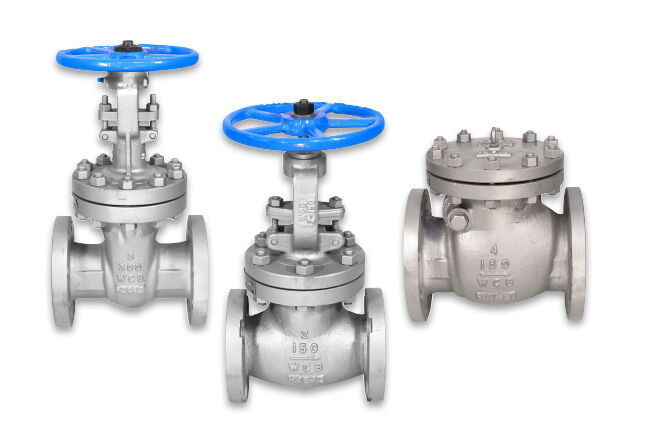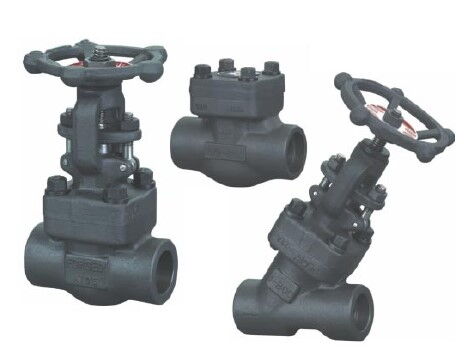In industrial settings, valves are critical components within piping systems, with their quality and performance directly impacting the overall safety and efficiency of the system. Forged steel valves and cast steel valves are two common valve types, differing significantly in materials, manufacturing processes, performance, and application scenarios. This article provides an analysis of the characteristics and distinctions of these two valve types, guiding readers on how to select the appropriate valves based on actual needs.
Before delving into their differences, it is essential to clarify the basic concepts of forged steel valves and cast steel valves to better understand the following content.
Cast steel valves are manufactured through casting processes. Casting involves pouring molten metal into molds and allowing it to cool and solidify into the desired shape. The primary advantage of cast steel valves lies in their ability to form complex shapes, which is particularly suitable for valve components that are difficult to produce by forging or machining. For instance, valves with intricate internal cavities can achieve precise shape control through casting. Cast steel valve materials mainly include cast carbon steel, cast low-alloy steel, and cast special steels. These materials enable cast steel valves to meet different requirements for strength and plasticity.

Forged steel valves are produced by forging, a process that applies pressure to cause plastic deformation in metals. Compared with casting, forging significantly improves the internal microstructure and strength of the metal by refining and homogenizing the grain structure, thereby enhancing mechanical properties. Forged steel valves are usually made from forged materials and forgings, offering higher quality than cast steel parts. They withstand greater impact forces and exhibit better plasticity, toughness, and pressure resistance. Thus, forged steel valves are often employed in critical machine components, especially under demanding conditions requiring high strength and ductility.

Next, we focus on analyzing the key differences between forged steel valves and cast steel valves. These differences span material composition, manufacturing processes, performance characteristics, and practical application scopes. Understanding these distinctions is essential for making reasonable choices in engineering projects.
Material Density
Forged Steel: Forged steel generally has a higher density than cast steel because the forging process produces a tighter, more uniform grain structure, resulting in higher material density. Higher density correlates with improved strength and mechanical performance.
Cast Steel: During liquid-state molding, cast steel may develop segregation and internal defects, leading to relatively lower density. Such defects can affect the valve’s strength and reliability.
Manufacturing Process
Forging: Forging is a plastic deformation process involving hammering or pressing metal billets with specialized equipment. This process improves the internal grain structure, enhancing strength and toughness. Forged components usually exhibit superior mechanical properties but tend to have simpler shapes, making it difficult to produce complex structures.
Casting: Casting forms components by pouring molten metal into molds and solidifying them. Casting excels at producing complex shapes but may introduce internal defects such as porosity and shrinkage cavities that impact valve quality and performance.
Strength and Toughness
Forged Steel Valves: Due to improved internal microstructure, forged steel valves offer higher strength and toughness. They can withstand greater impact forces, making them suitable for high-pressure and heavy-load environments.
Cast Steel Valves: These valves have comparatively lower strength and toughness but remain a good choice for applications requiring complex shapes with less stringent strength demands.
Pressure Ratings
Forged Steel Valves: Typically used in high-pressure applications, common pressure ratings include PN100, PN160, PN320, 1500LB–3500LB, etc. They are suitable for industries such as petroleum, natural gas, and chemical processing involving high-pressure systems.
Cast Steel Valves: These valves usually support lower pressure levels like PN16, PN25, PN40, 150LB–900LB, etc., fitting moderate- to low-pressure systems such as municipal water supply and general chemical applications.
Equipment Requirements
Forging: Forging equipment demands higher pressure and more precise control, leading to higher economic and technical costs.
Casting: Casting equipment is simpler and less expensive. For complex-shaped components, casting is an economically efficient manufacturing method.
Mold Costs
Forging: Forging dies are costly to manufacture and difficult to rework, making forging more suitable for large-scale production to amortize mold expenses.
Casting: Casting molds are easier and cheaper to produce, making casting a more cost-effective choice for small batch production or complex shapes.
After analyzing the main differences, we now discuss valve selection, an essential step that directly affects valve performance and service life under actual working conditions. Valve selection should be based on working conditions, medium characteristics, economic costs, and other factors to comprehensively determine the most suitable valve type and material.
Strength Requirements
For environments demanding high strength and toughness, capable of withstanding large impact forces and high pressure, forged steel valves are recommended. For example, in petroleum and natural gas pipelines, forged steel valves better endure high pressure and heavy-duty conditions.
When strength demands are lower but complex shapes are required, cast steel valves provide an economical and effective solution. Chemical equipment with complex valve shapes often benefits from cast steel valves.
Temperature Requirements
For high-temperature applications, materials with good high-temperature strength and oxidation resistance are preferred. For instance, A182 F91, a high-performance chromium-molybdenum alloy steel—is suited for ultra-supercritical and supercritical power plant steam systems.
For low-temperature applications, materials with excellent low-temperature impact toughness are needed. A350 LF2, a low-carbon steel with good low-temperature toughness and weldability, is often used in low-temperature valves.
Corrosive Media: For corrosive media, materials with superior corrosion resistance are essential. A182 F316, an austenitic stainless steel alloyed with molybdenum, offers enhanced corrosion resistance, particularly against chlorides, suitable for marine, pharmaceutical, and food processing environments requiring high corrosion resistance.
For chloride-containing environments, CF3M and CF8M, improved austenitic stainless steels with molybdenum, provide greater corrosion resistance and strength, suitable for chemical and pharmaceutical industries under high temperature and pressure.
Conventional Media: For conventional media such as water and oil, cost-effective carbon cast steel materials with good strength can be selected. WCB is a low-cost, high-strength carbon cast steel widely used in chemical and water supply industries with temperatures not exceeding 425℃.
Large Batch Production: For large-scale production, forging is recommended despite higher equipment and mold costs, as mass production spreads these costs and reduces unit product cost.
Small Batch Production: For small batch production, especially of complex-shaped components, casting is preferred due to easier and cheaper mold fabrication.
Having discussed selection criteria, here is an overview of commonly used materials for forged steel and cast steel valves, as their properties dictate valve suitability and lifespan.
Forged Carbon Steel
ASTM A105: Widely used carbon steel with good mechanical properties and toughness, suitable for various forged steel valves including gate, globe, and check valves, commonly used in oil & gas, refineries, and petrochemical industries under high temperature and pressure.
ASTM A350 LF2: Low-carbon steel for low-temperature environments with excellent impact toughness and weldability, often used for low-temperature valves.
Forged Stainless Steel
ASTM A182 F304: Austenitic stainless steel with good corrosion and oxidation resistance, applicable in various corrosive environments such as chemical, food, and pharmaceutical industries.
ASTM A182 F316: An enhanced version of F304 with added molybdenum for improved corrosion resistance, especially against chlorides, suited for marine, pharmaceutical, and food processing applications.
ASTM A182 F316L: Low-carbon variant of F316, with better weldability and resistance to intergranular corrosion, ideal for welded components.
Forged Alloy Steel
ASTM A182 F11: Chromium-molybdenum alloy steel with good high-temperature strength and creep resistance, used in high-temperature and pressure environments like power plants and petrochemical steam systems.
ASTM A182 F22: Contains higher chromium and molybdenum, offering better high-temperature strength and oxidation resistance for more severe conditions.
ASTM A182 F91: A high-performance chromium-molybdenum alloy steel with excellent high-temperature strength, creep resistance, and oxidation resistance, suitable for ultra-supercritical power plant steam systems.
Forged Duplex Stainless Steel
ASTM A182 F51: Combines austenitic and ferritic stainless steel properties, featuring high strength, good corrosion resistance, and stress corrosion cracking resistance, suitable for marine, chemical, and paper industries with corrosive media.
Cast Carbon Steel
ASTM A216 WCB: Low cost, high strength, easy to machine, suitable for conventional media at temperatures up to 425℃, widely used in chemical and water supply industries.
ASTM A352 LCB: Low-temperature carbon steel with good toughness and strength, commonly used for low-temperature valves and piping.
Cast Alloy Steel
ASTM A217 WC6: Low alloy steel with high heat resistance and corrosion resistance, suitable for non-corrosive media at -29℃ to 595℃, used in petrochemical and power industries.
ASTM A217 WC9: Similar to WC6 but with higher chromium and molybdenum content, offering improved mechanical strength and erosion resistance under high temperature and pressure.
ASTM A217 C12A: Good high-temperature oxidation resistance, creep strength, and plasticity, used for corrosive media at -29℃ to 650℃, often in supercritical power plant valves.
Cast Stainless Steel
ASTM A351 CF3: Low carbon austenitic stainless steel with good corrosion resistance and formability, suitable for food, pharmaceutical, and chemical industries with high cleanliness requirements.
ASTM A351 CF8: Medium carbon austenitic stainless steel with higher strength and good corrosion resistance, applicable for high temperature and pressure in chemical and petroleum industries.
ASTM A351 CF3M: Improved CF3 with added molybdenum for enhanced corrosion resistance, especially in chloride environments.
ASTM A351 CF8M: Improved CF8 with molybdenum addition, offering better corrosion resistance and strength, suitable for chemical and pharmaceutical industries at high temperature and pressure.
Forged steel valves and cast steel valves differ significantly in materials, manufacturing processes, performance, and application scenarios. Forged steel valves provide higher strength, toughness, and pressure resistance, making them suitable for high-pressure and heavy-load conditions. Cast steel valves excel in complex shapes and are suitable for applications where strength demands are moderate but shape complexity is high. When selecting valves, it is vital to consider working conditions, medium characteristics, and economic factors comprehensively to choose the most suitable valve type and material. Proper selection ensures valve safety and reliability in actual applications, thereby enhancing system efficiency and service life.
